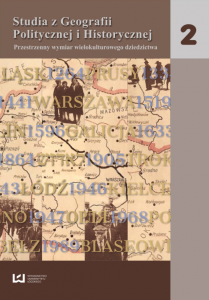Działalność społeczno-kulturalna mniejszości narodowych i religijnych w przestrzeni miejskiej Pabianic do drugiej wojny światowej
DOI:
https://doi.org/10.18778/2300-0562.02.12Słowa kluczowe:
działalność społeczno-kulturalna, mniejszość narodowa, mniejszość religijna, Żydzi, Niemcy, PabianiceAbstrakt
Mniejszości narodowe (głównie żydowska i niemiecka), tożsame na ogół z mniejszościowymi wspólnotami religijnymi, wniosły wymierny wkład w rozwój zarówno gospodarczy, jak i społeczno-kulturalny Pabianic. Głównym celem artykułu jest określenie charakteru i form organizowania w przestrzeni miejskiej aktywności społeczno-kulturalnej przez wymienione grupy.
Bibliografia
Adamek R., 1997a, Fabrykant z Pabianic. Karol Ender (1891–1956), „Życie Pabianic”, 31, s. 11.
Google Scholar
Adamek R., 1997b, Pabianiccy chasydzi – radość i taniec, „Pab Art”, 6, s. 8.
Google Scholar
Adamek R., 1998, Krusche, Ender, Kindler. Królowie bawełny w Pabianicach XIX–XX w. (katalog wystawy), Pabianice.
Google Scholar
Adamek R., 1999, Od kasy chorych do ubezpieczalni, „Nowe Życie Pabianic”, 1, s. 6.
Google Scholar
Adamek R., 2001a, Grupy chrześcijan, „Nowe Życie Pabianic”, 3, s. 6.
Google Scholar
Adamek R., 2001b, Gmina żydowska (cz. 1), „Nowe Życie Pabianic”, 20, s. 7.
Google Scholar
Adamek R., 2001c, Gmina żydowska (cz. 2), „Nowe Życie Pabianic”, 26, s. 7.
Google Scholar
Adamek R., 2003a, 90 lat prasy (cz. 14), „Nowe Życie Pabianic”, 25, s. 7.
Google Scholar
Adamek R., 2003b, Gazety Pabianic – 90 lat prasy nad Dobrzynką (katalog wystawy), Pabianice.
Google Scholar
Adamek R., 2005, Okres zaborów i międzywojnie, [w:] Adamek R., Nowak T., 650 lat Pabianic. Studia i szkice, Łódź.
Google Scholar
Adamek R., 2007, Tajemnice sprzed lat. Słynny rabin Alter, „Nowe Życie Pabianic”, 8, s. 8.
Google Scholar
Adamek R., Nowak T., 2005, 650 lat Pabianic. Studia i szkice, Łódź.
Google Scholar
Baruch M., 1903, Pabianice, Rzgów i wsie okoliczne. Monografia historyczna dawnych dóbr kapituły krakowskiej w Sieradzkiem i Łęczyckiem, Warszawa.
Google Scholar
Badziak K., 1992, Obraz burżuazji w Pabianicach. Baruchowie, [w:] Badziak K. (red.), Pabianiciana, t. 1, Pabianice, s. 87–103.
Google Scholar
Badziak K., 1993, Kindlerowie w Pabianicach. Aktywność gospodarcza i społeczna, [w:] Badziak K. (red.), Pabianiciana, t. 2, Pabianice, s. 111–140.
Google Scholar
Chudaś B., 2006, Rola mniejszości narodowych i religijnych w rozwoju Pabianic, praca magisterska napisana w Katedrze Geografii Politycznej i Studiów Regionalnych pod kierunkiem A. Rykały, Łódź.
Google Scholar
Eberhardt P., 2010, Migracje polityczne na ziemiach polskich (1939–1945), Poznań.
Google Scholar
Gramsz A., 2005, Dzieje Pabianic. Kalendarium do 1939 r., Łódź.
Google Scholar
Kalendarz. Informator Pabianicki 1914, 1913, Pabianice.
Google Scholar
Kulesza M., 1995, Rozwój przestrzenny miasta Pabianic, [w:] Badziak K. (red.), Pabianiciana, z. 3, Pabianice, s. 3–25.
Google Scholar
Markowski B., 1998, Kościół i parafia Najświętszej Maryi Panny Różańcowej w Pabianicach 1898–1998, Pabianice.
Google Scholar
Missalowa G., 1968, Dzieje Pabianic, Łódź.
Google Scholar
Peska R., 1999, Skazani na zagładę. Żydzi w Pabianicach 1794–1998, Pabianice.
Google Scholar
Puś W., 1992, Przemysł Pabianic w latach 1865–1914, [w:] Badziak K. (red.), Pabianiciana, t. 1, Pabianice, s. 75–86.
Google Scholar
Rykała A., 2007, Przemiany sytuacji społeczno-politycznej mniejszości żydowskiej w Polsce po drugiej wojnie światowej, Łódź.
Google Scholar
Tobjański Z., 1994, Czeskie osadnictwo w Pabianicach, „Gazeta Pabianicka”, 45–48.
Google Scholar
Tobjański Z., 1995, Mojżeszowi wyznawcy, „Nowe Życie Pabianic”, 6.
Google Scholar
Woźniak K., 1995, Protestanci pabianiccy (do 1914 r. Szkic do portretu), [w:] Badziak K. (red.), Pabianiciana, t. 3, Pabianice, s. 63–87.
Google Scholar
Żbikowski A., 2010, Zagłada polskich Żydów w latach II wojny światowej, [w:] Sienkiewicz W. (red.), Atlas historii Żydów polskich, Warszawa.
Google Scholar
Pobrania
Opublikowane
Jak cytować
Numer
Dział
Licencja

Utwór dostępny jest na licencji Creative Commons Uznanie autorstwa – Użycie niekomercyjne – Bez utworów zależnych 4.0 Międzynarodowe.








